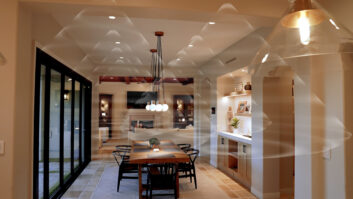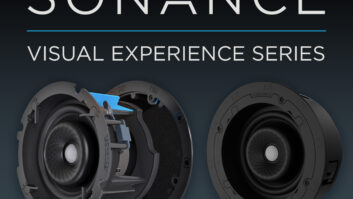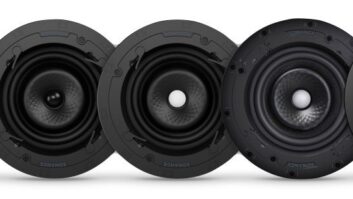In 1983, Sonance co-founders Geoff Spencer and Scott Struthers had a brainstorm of an idea. They took hi-fidelity box speakers and created a way to conceal them in a wall. Since that time, Sonance has been on the leading edge of what it eventually dubbed “Architectural Audio.”
Last month, Sonance announced that Spencer and Struthers would return to their management roles after maintaining board of directors positions in recent years. The industry veterans say that they plan on reclaiming customer relationships and the product development roles that were the duo’s hallmark years ago.
In a conversation with Residential Systems, Struthers describes the latest developments at Sonance.
Jeremy Glowacki: Explain the motivation behind the recent changes in day-to-day leadership at Sonance.
Scott Struthers: Geoff and I started the company 20 years ago, and we have a lot of really strong relationships out there. We’re very excited about the opportunities of the company, we’ve always been oriented toward high-end products, and we’re very proud of the customers we have. As we look ahead three, four and five years, we had to decide how best to utilize the energies and resources of the company. We really wanted to make sure that the goals that we have were going to be achieved and would work. Geoff and I enjoy hands-on roles and really want to keep in touch with the company and the customers. We wanted to get closer to our customers.
Did you feel that there was something lacking in that regard with the previous leadership?
[Previous CEO] Chip [Brown] did a lot of very positive things for the company, but Geoff and my customer relationships have gone on for 20 years. Some of those are best handled by us getting closer, keeping in touch with them and making sure that there’s consistency from us.
Is Chip coming back at all in a position within the company?
No, he’s not.
It seems that you brought in a lot of managers-instead of industry people-into the company over the years. Did you feel you went too far in that direction?
As we grow, I think we’re learning better and better the right balance between simply straightforward business skills and industry knowledge. The industry is not that big, but it’s harder and harder to communicate with the “core business” guys who are doing the really high-end homes in Aspen and Montana, for instance. Everybody’s chasing them, everybody’s trying to get them. The great news is that we’ve had relationships with these guys for 15 or 20 years and there are a lot of people in the industry who have only known them for 10 or 15 years. There’s a balance there. We’re trying to find out what that right balance is and always trying to find the best people for the right jobs.
There have been some other personnel changes in the company recently. Did the turnover cause you concern and contribute to your decision to make a leadership change?
We’re definitely committed to always having the best people here. We certainly don’t like turnover, and it’s our goal to have people have a wonderful place to work. We’re always trying to improve that. As we go into the future, there have been people who enjoyed working with us in the past… they have said that even as they’ve left the company they may come back and say hello and may even go farther. I don’t know exactly what’s going to happen on that.
How have you been received by your staff so far?
We’ve been received here very well. I think a lot of it goes back to the fact that we’ve been here for 20 years, and I think that it’s good that people get to work with us and we’re not just the people who would come in here on an irregular basis.
How much did your involvement on the Board bring you into the office?
We have been involved from a strategic basis and from a governance basis. It was part of our daily activities to somehow do something with Sonance. It wasn’t necessarily part of our daily routine to be in company meetings, departmental meetings or doing a lot of detail work, but we did our best to stay in touch and have our hand in the overall strategic directional decisions made in the company.
So, what specific roles will you and Geoff take on within the company?
I’ve always been somewhat into the sales and marketing side of the world, and Geoff has always been the R&D operations guy. Geoff and I have worked together for many, many years like that.
Since you’ve left, what do you say is the biggest change toresidential technology that might require a little bit of catching up for you?
I don’t think we’re that far out of the loop. You’re seeing more digital, obviously, than you’ve ever seen before down to amplifiers. You definitely see video as a lot more dominant than it was five or 10 years ago. Control is more sophisticated than it ever was, but it’s also simpler than it ever was.
Do you agree with your company’s plans, that were initiated last year, for regional sales territories?
Yes. We’re not making any major changes. If there’s a number one thing we’re doing right now, it’s listening. Yesterday we got together with a bunch of representatives from Florida, Denver, Chicago and Seattle. One of the things, again, that is our real strength is communication and making sure that we listen very well and communicate very well so that there’s clarity in the company plan, clarity is what the logos mean, clarity in what we’re doing so there’s no confusion, no surprises out there in the field, there’s nothing hopefully but a wonderful feeling when you think of our company.
There has been a trend in the past few years for companies, including Sonance, to branch out from a core products into a several diverse categories. With your distance from the industry, what did you think about this trend?
We actually had that discussion the other day. I think that it goes back to understanding the business and understanding how we can best add value. One of the reps, and this is only one data point, pointed that a lot of times when it comes to Cat 5 wire that’s something very much like electrical tape on the truck and is not an area where we can add as much value as we can to an in-wall speaker. Where we really have a lot of the resources that nobody else has… Wire is a very important thing, but I don’t believe we can add as much value there as we can in other places. We have to pick the right areas where the company can add the most value and we are still a fairly small company.
Jeremy J. Glowacki is editor of Residential Systems.







